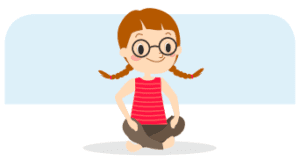What is it?
W-sitting is when a child sits on their bottom with bent knees and their feet are resting on either side of their body. It is called ‘W-sitting’ because from a bird’s eye view, the child’s legs form a “W.”

Why do children prefer this position?
This position provides a wider base of support and increased stability to the child’s trunk and core when sitting. It is often used to compensate for decreased trunk strength or increased flexibility.
The effects of W-sitting
- Shorter and tighter leg muscles which can later impact a child’s gross motor skills and overall coordination
- Increased risk for hip dislocation
- Locks the child’s trunk in to one position which can impact upper body rotation and bilateral coordination
- Delayed core muscle development because the muscles are left unused as the child is relying on their legs for stability. Decreased trunk strength and stability can impact a child’s fine/gross motor skills, balance, and stability.
How to decrease W-sitting
- Redirect your child to sit criss cross when W-sitting is observed

- Increase your child’s core strength:
- Animal walks
- Yoga poses
- Wheelbarrow walks
- Engage in activities in different play positions
- Play at the table as this requires your child to sit in a chair in an upright position
If you notice your child frequently W-sitting, it may be beneficial to have your child evaluated by an occupational therapist to make sure w-sitting is not impacting their ability to be independent and functional in their daily lives.
Contact Chicago Occupational Therapy or call (773) 980-0300 to learn more about our services and how we can help your child flourish and grow.

